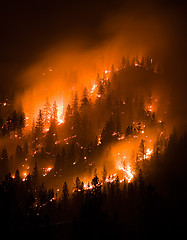 Forest fires and other blazes in the US release about 30 percent as much mercury as the nation’s industrial sources. Initial estimates from the National Center for Atmospheric Research find that fires in Alaska, California, Oregon, Louisiana, and Florida emit particularly large quantities of the toxic metal, and the Southeast emits more than any other region. The mercury released by forest fires originally comes from industrial and natural sources.
Forest fires and other blazes in the US release about 30 percent as much mercury as the nation’s industrial sources. Initial estimates from the National Center for Atmospheric Research find that fires in Alaska, California, Oregon, Louisiana, and Florida emit particularly large quantities of the toxic metal, and the Southeast emits more than any other region. The mercury released by forest fires originally comes from industrial and natural sources.
The researchers estimate that fires in the continental US and Alaska release about 44 metric tons of mercury into the atmosphere yearly. They caution their estimates are preliminary and subject to a 50 percent or greater margin of error. A next step will be to examine how much mercury is deposited on nearby downwind areas, compared to how much travels around the hemisphere. Most mercury from fire is gaseous, traveling thousands of miles before coming down in rain or snow. About 15 percent is associated with airborne particles, like soot, some of which may fall to Earth near the fire. “We would like to determine the risk of mercury exposure for residents who live downwind of large-scale fires,” says author Hans Friedli.
Even more disturbing in light of the fact that the number and extent of wildfires are forecast to increase—and in fact already are—another pesky byproduct of global warming.
Julia Whitty is Mother Jones’ environmental correspondent. You can read from her new book, The Fragile Edge, and other writings, here.
















